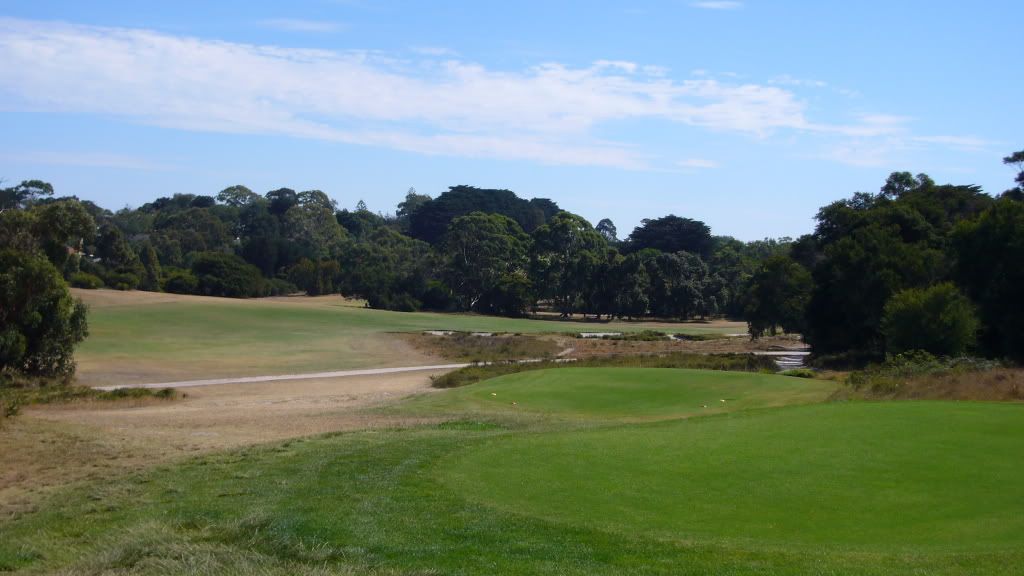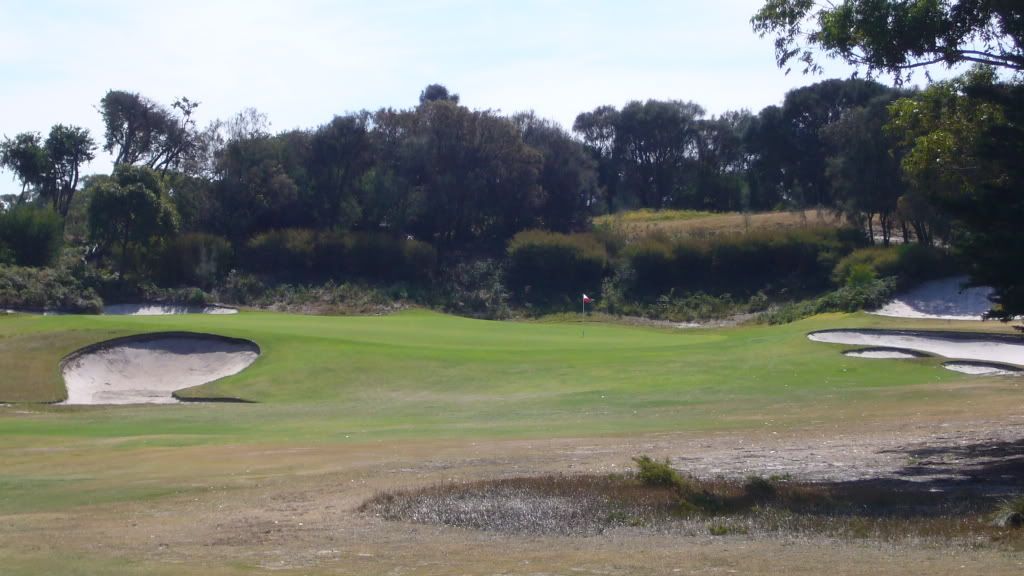How do you card a 7 on the 451-yard, par 4 6th hole? Make a three-footer!
En route to victory in the final round of the 2004 Heineken, Ernie Els dumped his approach into the deadly clamshell bunker fronting the left side of the green that belongs to RM West, where it plays as the 6th. (Not to confuse things further, but in the Composite routing used in the tournament it served as the
fourth hole.)
His third shot skidded past the pin, located on the deadly front portion of the green, off the green and down the hill. His chip didn't summit -- or summited Mt. Everest style, which is to say all too briefly -- and when it finally stopped Els found himself even farther away than where he started.
Warming to the task, and perhaps gaining an appreciation of Peter Thomson's "loss-cutting" insight, Els's fifth shot brought him to eight feet. His first putt, for a six, got him to three feet, from where he took his seventh and final stroke.
This is not to disagree the course has gotten too short for the pros, but it's funny how everyone remembers the course-record Els shot 60 the day before. Nobody seems to recall Els shot a 74 the next day.
A better point about Els's Jeckyll-and-Hyde back-to-back rounds (than concluding the course has gotten too short / easy) is one that used to be made about the old, now NLE Augusta National: low scores are out there for the heroic, but so is disaster.
The 6th offers two clues to how Royal Melbourne achieves that:
1) A dogleg that rewards drives both well struck and well positioned
2) A green that Ran Morrissett has written "features some of the boldest contours in championship golf"
It's true the course makes brilliant and frequent use of doglegs, and aren't doglegs a tried-and-true method for girding a design against whatever monsters may lie over the technology horizon?
After holing out on the 5th, the golfer takes a short walk to 6 tee, which, as it lies on the same ground as 5 green, provides an elevated look at the fairway below. The decision: how much does he challenge the cluster of bunkers, not to mention scrub, in the crook? It's a crucial question, for the farther left one bails out the closer his chances of scoring a 5.
One other point to make using the picture below taken from the tee: the cant of the fairway from left to right. One aspect of RM's doglegs that could use more attention is the relationship of the dogleg to the tilt of the fairway. It's like that game where one must guide a steel ball down a slope between two rods; how far down the slope do you think you can go?
Here the slope offers help
in proportion to the risk the golfer chooses, which is good if we're taking the risk because we need all we can get on a hole of this length. (If the golfer bails out left, the slope gives him little -- the upslope provides a bit of a "brake" to keep him from going too far and thus losing the angle for his next shot, which will be a layup.)
A good example of how slope is used to a different effect in relation to the dogleg is the short 8th (RMW10). That hole sees the fairway cant
hurting the golfer. These cants, in their relationship to the doglegs, introduce an entirely new calculation into the risk-reward "summing up" that Thomson's quote so wonderfully captures.
One question I do have about optimal position: Mike Clayton in WAOG writes that the best position is just over the sand in the dogleg, that the farther across the fairway one carries the ball the farther one diverts from the ideal line of approach. Is this reference to the back-left pin position or is it Position A no matter the flag?
6 Tee: one minor observation to note is the view through to 4th fairway (RME2). There are many, many such vistas made available by the profusion of doglegs. These vistas not only provide an "economy" in views or sightseeing, they contribute to the challenge by making depth perception tricky on the bailout route.

The golfer who takes the bold route and succeeds finds that his well-struck drive merely privileges him to consider a shot that, for a complete absence of water, chasms, cliffs, arroyos and any other golf pornography, might be one of the most-frightening in golf. We have both Neil C's and Ernie Els's experiences to help us understand why. The golfer who of free will chooses to bring 3 into play also chooses to bring 5...6...7 into play.
6 Green, with hole in difficult front-right location: members now sometimes refer to the front-left bunker as the "Els Bunker." Of course, it's a moveable feast of sorts: Sam Snead in the 1959 Canada Cup putted off the green into this bunker.

Final word: Golf Magazine named the 6th hole one of the world's 18-greatest holes -- and named the 5th the greatest 5th hole in the world (and one of the world's 100-greatest). Back-to-back architectural excellence!
Mark